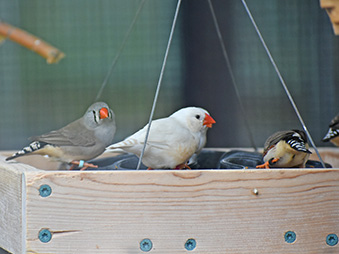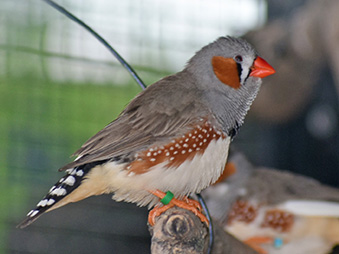Taeniopygia guttata | Australian Zebra Finch
Names:
- Male: Al Dente, Alfredo, Fettuccine, Macaroni, Noodle, Orzo, Ramen, Tortellini, Ziti, Fusilli
- Female: Cannelloni, Capellini, Cavatappi, Spud, Butter, Carbonara, Bechamel, Pesto, Gemelli, Hollandaise, Risotto, Scampi, Korma, Mostaccioli, Couscous, Orecchiette, Soy, Palomino, Marinara



Meet the Pasta Flock!
Say hello to Ziti, Rotini, Ravioli, Fusilli, Tortellini, Ramen, Udon, Soba, Farfalle, Cannelloni, Cavatappi, Capellini, and Ditalini—our charming flock of Zebra Finches! These tiny, energetic birds are full of life, songs, and social smarts. Native to Australia’s arid interior, and naturalized in part of Indonesia, Zebra Finches are one of the most well-studied songbirds in the world, and they have a lot to chirp about.
Small Birds, Big Style
Zebra Finches are easy to recognize, especially the males, who wear:
- Black-and-white “zebra” striping across their throats.
- Bright orange cheek patches.
- Bold reddish-orange beaks.
Females are more subtly colored with lighter beaks and no cheek patches—but they’re just as active and just as vocal (though they don’t sing like the males do).
Made for the Outback
These finches thrive in savannas, dry grasslands, and semi-arid scrublands, preferring areas with access to open terrain and a water source. You can find them throughout mainland Australia, even in areas heavily influenced by human activity like water troughs and cultivated lands. Their adaptability is one reason they’re listed as a species of Least Concern.
Zebra Finches do incredibly well in harsh, dry climates, where other birds might struggle. They are able to survive on very little water, getting most of their moisture from their food, and have even been observed breeding after just a single day of rainfall, taking quick advantage of brief periods of abundance.
In the wild, general flocks easily reach 100+ birds, but during mating season, these flocks break into about 50 individuals per group. They are able to identify if an individual is a part of their flock by their song. Individuals with recognizable songs will group back together after the mating season is over and individuals with songs that are not recognizable, will be chased away.
Family Comes First
One of the most fascinating things about Zebra Finches is how dedicated they are as parents. They form pair bonds and are considered monogamous, which means that they stay with one partner for their entire life.
- Both males and females build the nest and share incubation duties.
- A typical clutch has 4–6 eggs.
- Chicks hatch after about 2 weeks and are fully fledged by 5 weeks.
- Male chicks learn their songs from listening to their fathers.
- Each male’s song is unique, passed down through generations like a family recipe!
This strong parental teamwork makes Zebra Finches a favorite species for studying learning, vocal development, and social behavior in birds.
What's for Dinner?
In the wild, Zebra Finches are omnivorous and forage for:
- Seeds
- Fruits
- Vegetables
- Small insects, especially during breeding season
At the zoo, their meals include:
- Finch seed blend.
- Fresh kale.
- Purina Gamebird Chow, formulated to support their active metabolism.
- Hard-boiled egg with the shell to help with egg production.
Fact Sheet
Taxonomy
Genus: Taeniopygia | Species: guttata |
Kingdom: Animalia | Phylum: Chordata | Class: Aves | Order: Passeriformes | Family: Estrildidae |
Favorite Enrichment Type
Newspaper strips, emu feathers, small boxes to hide in, shredded paper.
Diet
- In the Wild: Seeds, fruits, vegetables, and insects.
- At the Zoo: Purina Gamebird Chow, wild finch seed, kale, and hard-boiled egg with the shell.
Life Span
- In the Wild: Average of 2 to 3 years old, living up to 5 years.
- In Human Care: Average 5 to 7 years old, living up to 14 years.
Geographic Range
Widespread across mainland Australia and have been naturalized in parts of Indonesia.
Habitat
Live exclusively in savanna and subtropical dry habitats with non-vegetated terrain. They also do well in human disturbances such as water holes and cleared land.
Finch Fast Facts
- One of the most widely studied birds in science.
- Males learn to sing by mimicking their fathers.
- Can begin breeding just days after rain.
- Highly adaptable to arid environments.
- Social—live in flocks, not alone.
- Use twigs, feathers, and even string to build cozy dome-shaped nests.
Status: Least Concern
Why Zebra Finches Matter
Zebra Finches have been instrumental in helping scientists understand:
- How animals learn language and sound.
- The importance of vocal communication in mate selection.
- How environmental stressors can affect brain development and behavior.
Their quick reproductive cycle and vocal learning abilities have made them a model species in neuroscience and behavioral studies. They're not just cute—they’re smart!
Tiny, tough, and tremendously talkative, Zebra Finches like Ziti and the gang are proof that even the smallest animals can have big ecological and scientific importance. Stop by to see (and hear!) them chirping away and celebrating flock life every day.
How to Find Us
Our flock of finches lives just past the entrance to the Zoo, on the left-hand side before the Covered Bridge. Look for the colorful, flitting movement and soft chirps of conversation as they go about their day socializing, preening, and singing to one another.
